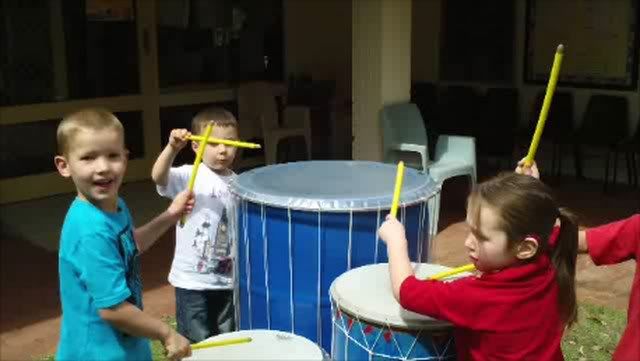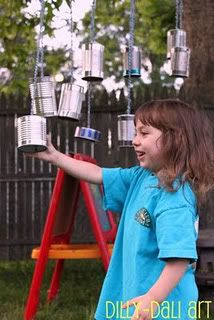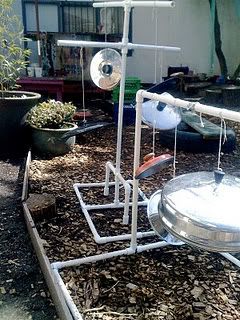 |
| Just 6 of my 60+ homemade instruments. |
I’m Alec Duncan from Child’s Play Music in Perth, Western Australia. I’m a qualified early childhood educator and I’ve been working with young children since 1988, originally in child care and out of school hours care programs.
Since 1998 I’ve been facilitating hands-on play-based instrumental music programs with young children, using homemade instruments I make mainly from junk and recycled materials.
I'm passionate about play-based learning in all its forms, but naturally my focus is on music in the early years. I want all children to experience the joy of learning music through play so my first post is all about how you can radically increase opportunities for music play in your program.
I'm of Scottish heritage. While I draw the line at wearing a kilt or eating haggis, like many Scots I love a bargain. And the best sort of bargain is a freebie. Most of these ideas won't cost you a cent, and they may just save your sanity too!
Music and the power of play-based learning
The natural way for young children to learn anything is through free, self-directed play. Just as children should have free access to blocks for construction and to props for dramatic play, musical instruments should be available on a self-choice basis so they can learn about music through free play and exploration. But in a classroom that can sometimes present real problems.
Music play tends to be loud. Sometimes too loud, especially inside in a classroom. A few children exploring instruments can create an amazing level of noise that can interfere with other children’s play and learning, and have you muttering: "the noise is driving me nuts!"
Often educators respond by restricting access to instruments, or only using them in structured group times, or by enforcing a “play quietly” rule. That’s understandable, but there’s a better way:
Take your music program outside!
Your outdoor playground area isn’t just a place for children to let off steam – it’s a learning environment that is just as important as your classroom, maybe more so. There is nothing – absolutely nothing – which you can do indoors that you can’t do outdoors. There are many learning experiences that can only happen outside. And some things just work better outdoors, and music for young children is one of them.
In my music programs I use homemade drums like these:
 |
| These drums are loud! I mean, really loud! |
Source: Child's Play Music
Would you want those drums inside? No way, and neither would I; but in the open air the volume level is greatly reduced. The sound doesn’t echo and reverberate the way it does indoors and you have ample room to space your instruments away from other activities.
Music play is instantly easier to implement. Free choice of music play by children becomes something that’s pleasant and natural, and children love the freedom that outdoor music making brings.
Many of your indoor instruments will work just fine outside, though you do need to think about the weather – you don’t want your instruments being rained on. Choose instruments that are rugged and loud, like drums, tambourines, bells, wooden tone blocks, shakers, guiros and metal or wooden xylophones. Set them up on tables or mats, or on a grassed area and watch the children flock to them!
Keep your delicate quiet instruments for indoor use – and since they are quiet you can have them available at all times. You’ve just vastly increased your children’s access to music play – and kept your sanity at the same time. Bonus!
But, wait – there’s more!
It’s not just the noise factor that makes the outdoor area so perfect for music play. You have space to create music stations and music walls, using recycled and re-purposed junk. No worries about these instruments being rained on!
Music stations can be as simple or as complex as you want to make them:
 |
| How simple is this? |
 |
| A modular PVC frame - no need to glue it. |
Source: Dilly-Dali Art ......................................................Source: Teacher Tom
 |
| A nice mix of found objects and "real" instruments |
Source: Pre-School Play
Creating a music station is easy and it’s a wonderful project to do with young children. Don’t just build it yourself – involve the children at every stage of the design and construction, for maximum learning. It can be an ongoing project, with children keeping your music station fresh and interesting by continually adding new objects as instruments.
 |
| Real tools = real learning |
Source: Teacher Tom
You can extend your fixed music station with loose parts. Metal garbage cans make great “thunder drums”, and large PVC containers work really well. Cardboard boxes are great too, and for added melodic interest try random lengths of PVC pipe played on the end with a rubber sandal. Diameters from 40mm upwards work best.
 |
| Nice homemade xylophone - and loose parts drums |
Source: let the children play
Check my Pinterest boards for more images of music stations and loose parts.
Want more instruments? You have them already!
Maybe you don’t have many “real” musical instruments available to you. Not a problem: your outdoor area is jammed full of instruments already! No, really – they just don’t look like musical instruments.
Playground equipment and outdoor features make wonderful instruments in their own right. Practically anything can be a musical instrument if it can make a sound.
Watch this short video of 4 and 5 year old children spontaneously exploring their playground (you might want to turn your speakers down – this is pretty loud!)
That’s pretty impressive, although in their enthusiasm to explore they seem to have forgotten my rule about walking with drumsticks. Tsk, tsk.
What else works?
- Fences, forts, climbing frames, gutter down pipes, drinking fountains, tricycle frames, – anything metal or wood.
- Plastic forts, ride-on toys, large waffle blocks (make a cube of them for a cajon you can play while sitting on it), plastic playground barrels – put a shovel-full of small stones or bark chips inside and you have the world’s largest shaker.
- Any rough textured object can become a scraper or guiro – concrete paving, bricks, asphalt, tree trunks with rough bark – use sticks or scrubbing brushes for scraping.
- Natural materials like dry leaves, sticks, bark, stones, hollow logs – all can create interesting and unique sounds
The only limit is your imagination – if it can make a sound and is relatively unbreakable then it can be a musical instrument. Explore your area with your children to find all the sounds; I guarantee both you and the children will be amazed at the range of sounds – and they won’t cost you a cent.
Get up and boogie!
Your outdoor area is also perfect for movement to music. Children have the freedom to make large movements safely, and if you have small portable musical instruments that children can carry while playing, movement to music comes instinctively.
 |
| Dance, dance, dance! |
Source: Child's Play Music
Dance is fundamental to children’s understanding of music – and it’s also fantastic exercise! In a time when we are all becoming more concerned about children’s reduced physical activity, movement to music is a wonderful way to get kids up and active. Often children who don’t normally choose gross motor activities will respond enthusiastically to movement to music.
There's so much you can do with music and play outdoors!
One last thing:
Yes, your outdoor area can be a wonderful place for music play - but I'm not say it should be the only place. I'm hoping that these ideas will extend your music program and make it even more vibrant. A great music program is one that uses your whole environment, indoors and outdoors, and offers children a wide range of music activities and play opportunities.
So, yes, a free choice of music activities is important but so are more structured play-based activities at circle or mat time, so are extensive opportunities for singing and music to movement throughout the day, so are listening stations where children can listen to the recorded music of their choice. It's all about offering a rich, diverse and engaging music program for children to explore the joy and wonder of music.
Until my next post:
Have fun - and keep playing!
If you've enjoyed this post check out my blog at Child's Play Music, where you will also find video tutorials on making simple musical instruments with children. You can find Child's Play Music on Facebook too. And Pinterest!Proudly linked to: Hands on: as we grow - it's playtime! No Time for Flash Cards - Link & Learn; Adventures in Mommydom - Science Sunday; Beneath the Rowan Tree - Playdate; playing with words 365 - Thrifty Thursday; Homeschool Creations - Preschool Corner; Toys in the Dryer - Fun Stuff Fridays; Mama Pea Pod, Greening Sam & Avery, Learning for Life - Outdoor Play Party; Living Life Intentionally - TGIF Linky Party; NurtureStore - The Play Academy; Child Central Station - Outdoor Classroom Inspiration.


Bravo - amazing and inspiring! what lucky children to be involved in any of your programs. The wonder of music is certainly a gift! The creativity of your instruments astounds me!
ReplyDeleteAlec, LOVE this post!! I can't wait until spring to get outside more, and I honestly wouldn't have even thought of doing music outside like this! Thanks for sharing at Thrifty Thursday this week!
ReplyDeleteAn inspiration, Alec, even to me who's always used music freely. Bravo. I am very noise-sensitive and have always needed to control the use of instruments in the classroom for my own sanity (and that of other noise-sensitive children, eg those with autism). The idea of using more durable, home made instruments plus loose parts outdoors is so freeing. Fantastic.
ReplyDeleteAlec, I add my applause to that of your fans above!!!! This is such a delightfully comprehensive article. So many resources. So many ideas. So much inspiration!!!! I had the good fortune to read the article in its draft form and knew it was going to be a 'grand-slam' (pardon the baseball analogy down-under) and a gen-un-ine contribution to the ECE community at large. Wish we could get your articl in front of a TON of readers. Keep it comin'..... you've set the bar pretty high, but can't wait to hear what other ideas you have to share!!! Cheers!!!!!!!!
ReplyDeleteThank you so much for including us! The cans in the tree really is so simple but my daughter's face says it all, she loved it. This is a wonderful post and I can't wait to put some of these ideas into motion, I'm loving that music wall! That would work perfectly on my back porch!
ReplyDeleteThank you!!
Aleacia @ Dilly-Dali Art
Thanks to everyone for your kind words!
ReplyDelete@Aunt Annie - I've often found that children with noise sensitivity issues are fine, so long as it is them making the noise! I frequently work with children with ASD, and although some do find the noise difficult to deal with many cope very well, even ones who have noise issues. If you have a look at my videos on my website http://childsplaymusic.com.au/videos-images/ two of the children have ASD/Asperger's and one was described to me as having extreme noise sensitivity issues (I won't identify which child, of course, or even which of the two videos they appear in). That child spent ages playing the drums and other loud instruments and features quite a lot in the video. You would never think that the child has noise issues, but I saw it after the session, when the child got very distressed when somebody dropped a steel fruit platter by accident. (Sorry about the clumsy repeated use of "the child", but I don't even want to identify him/her by gender)
@Aleacia - no, thank you for permission to use your lovely photo! I love simplicity and I love a bit of creative recycling. Things don't have to be complicated to work well. The other thing I like about your cans is that you created the instrument together with your children, you didn't just make it yourself. Those sort of real hands-on experiences are exactly the sort of things that foster real learning.
Oh, Alec~ what a wonderful post! You are inspiring some pretty cool ideas! The air here is filled with the smoke of my wheels turning! ;) Thanks for the inspiration! :))
ReplyDeleteWow, this is wonderful. Maybe you should open a music theme park for family music vacations. I think what you are doing is something all children would enjoy and should be given the opportunity, in my opinion. I am impressed. Carolyn
ReplyDeleteWhat an amazing post it is too. Will definately be referring back for my planning this year. Congrats and all the best.
ReplyDeleteI am inspired to seek out a little corner for music play in our garden this Spring and Summer! It is a small garden, but am sure I can find something!
ReplyDeleteMaggy
Combining music and the outdoors....Two of my favorite things!!
ReplyDeleteLooks like you guys are having a lot of fun! I really like the music stations and the classroom drums you have set up. These definitely encourage the students to move and make music.
ReplyDeleteWow ... awesome post, Alec! I'm so glad to see you here at PreK + K Sharing! Your ideas for outdoor music and instruments are truly inspirational. I pinned your post to my Kids' Music Activities Pinterest board at http://pinterest.com/debchitwood/kids-music-activities/
ReplyDeleteGreat Ideas here. I love the music wall made of found materials. A great way to teach kids that music is everywhere - no fancy equipment needed.
ReplyDeleteChildren enjoying themselves. They will be great Music Instruments players few years to come.
ReplyDelete